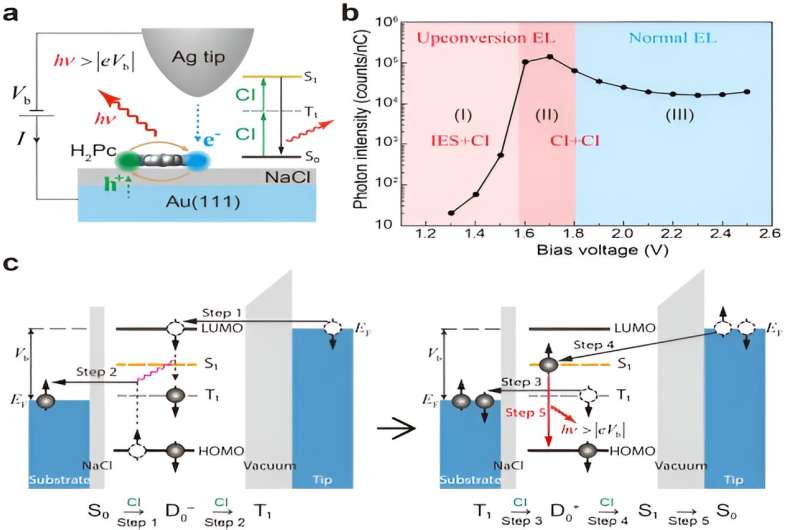This article has been reviewed according to Science X's editorial process and policies. Editors have highlighted the following attributes while ensuring the content's credibility:
fact-checked
peer-reviewed publication
proofread
Researchers observe anomalously bright single-molecule upconversion electroluminescence phenomenon

A research group has developed a new and highly efficient upconversion luminescence mechanism by scanning tunneling microscopy (STM) induced luminescence to observe an extraordinarily bright single-molecule upconversion electroluminescence (UCEL) phenomenon for the first time. The results are published in Nature Communications.
UCEL is a kind of phenomenon in which a material emits high-energy photons under low-energy electronic excitation. An in-depth understanding of the micro-mechanisms of these interactions and the micro-processes of energy conversion is crucial for expanding the applications of the upconversion process in organic optoelectronic devices, as well as in photosynthesis.
The researchers were led by Prof. Zhenchao Dong from University of Science and Technology of China (USTC) of Chinese Academy of Sciences. Prof. Dong's group has long been devoted to developing a coupling technique that combines high spatial resolution characterization of STM with highly sensitive detection by optical techniques, which provides a powerful means of observing and modulating the optoelectronic behaviors of molecules on a single-molecule level.
While limited by the inefficiency of inelastic electron scattering excitation, the efficiency of the single-molecule upconversion luminescence proposed by the group is very low. Besides, efficient upconversion luminescence mechanisms in macroscopic systems, such as triplet-triplet annihilation and the Oechs effect, are difficult to function effectively in single-molecule systems. Hence, achieving efficient single-molecule UCEL is still a challenge.
Combining STM-induced luminescence technology and controlled engineering of the energy-level alignment at the single-molecule interface, the team succeeded in improving the efficiency of single-molecule UCEL by more than one order of magnitude compared with that previously reported. Surprisingly, they found that the intensity of single-molecule upconversion luminescence measured under upconversion bias even exceeds that of electroluminescence under normal bias.
The researchers found that the limitations of the inefficient inelastic electron-molecule scattering could be eliminated through the fine-tuning of the energy-level alignment at the molecular interface, realizing a brand-new high-efficiency upconversion excitation mechanism that involves the pure carrier injection process.
The mechanism can make good use of the spin triplet state of a single molecule, the anionic and cationic charging states, etc., and these were set as intermediate states. Based on the mechanism, the energy of two low-energy tunneling electrons was transferred into the molecule sequentially through a multi-step carrier injection process, achieving efficient excitation of UCEL from spin triplet to singlet molecule excitons.
According to the new mechanism proposed by Prof. Dong and colleagues, the upconversion luminescence efficiency is over two orders of magnitude higher than the previously reported upconversion luminescence efficiency involving inelastic scattering processes.
The researchers also further developed a theoretical model based on the quantum master equation and constructed an electroluminescence map for understanding the luminescence efficiency of single molecules in relation to the energy-level alignment.
This model not only visualized the prerequisites for achieving efficient upconversion luminescence, but also revealed the dependence of single-molecule electroluminescence on bias and energy-level alignment.
The study improves the efficiency of single-molecule upconversion electroluminescence, and provides a new understanding of the single-molecule scale nonlinear electro-optical conversion process.
More information: Yang Luo et al, Anomalously bright single-molecule upconversion electroluminescence, Nature Communications (2024). DOI: 10.1038/s41467-024-45450-5
Journal information: Nature Communications
Provided by University of Science and Technology of China





















